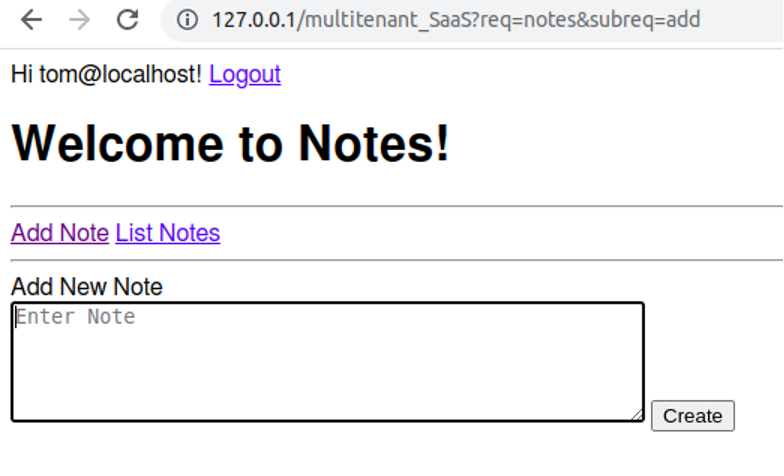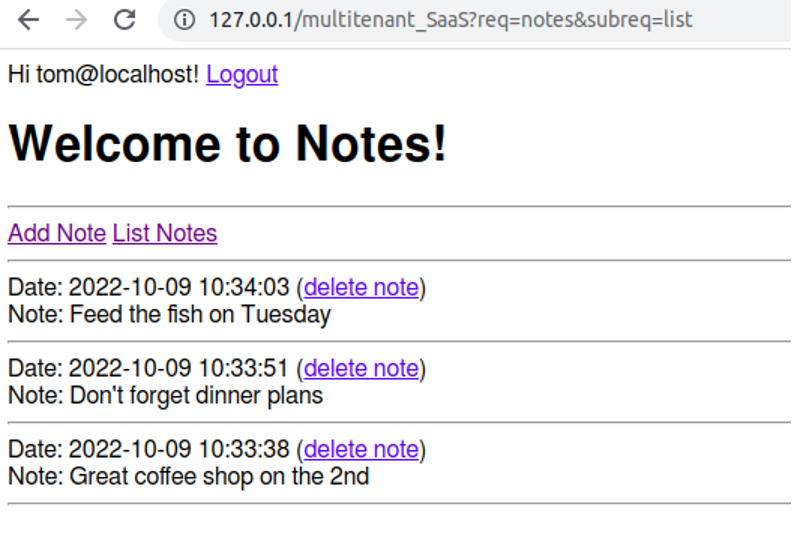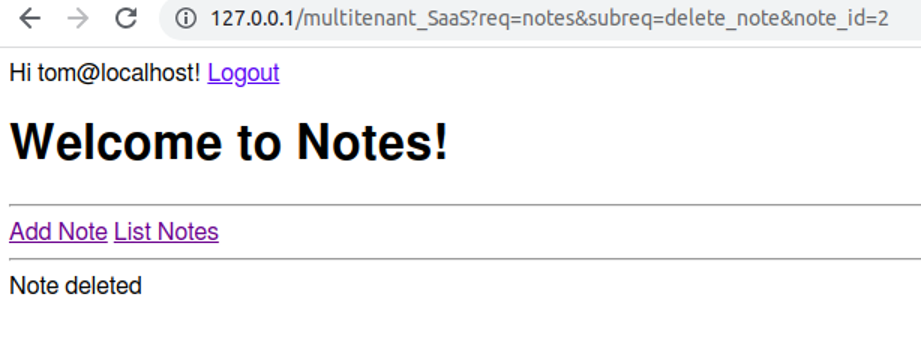使用 Vely 在 Linux 上构建您自己的 SaaS
Vely 使您可以在 Web 应用程序中利用 C 的强大功能。
Vely 将 C 的高性能和低占用空间与 PHP 等语言的易用性和更高的安全性结合在一起。它是免费的开源软件,根据库的 GPLv3 和 LGPL 3 许可,因此您甚至可以用它构建商业软件。
使用 Vely 进行 SaaS
您可以使用 Vely 创建多租户 Web 应用程序,并将其作为软件即服务 (SaaS) 在 Internet 上运行。每个用户都拥有与其他用户完全独立的数据空间。
在此示例 Web 应用程序中,用户可以注册笔记本服务来创建笔记,然后查看和删除它们。它仅用 7 个源文件中的 310 行代码演示了多项技术集成。这些技术包括:
- 玛丽亚数据库
- 网页浏览器
- 阿帕奇
- Unix 套接字
怎么运行的
以下是从用户角度来看该应用程序的工作原理。图像后面是代码演练。
该应用程序允许用户通过指定电子邮件地址和密码来创建新的登录名。您可以按照自己喜欢的方式设置它们的样式,例如使用 CSS:
(塞尔吉奥·米贾托维奇,CC BY-SA 4.0)
验证用户的电子邮件:
(塞尔吉奥·米贾托维奇,CC BY-SA 4.0)
每个用户都使用其唯一的用户名和密码登录:
(塞尔吉奥·米贾托维奇,CC BY-SA 4.0)
登录后,用户可以添加注释:
(塞尔吉奥·米贾托维奇,CC BY-SA 4.0)
用户可以获得笔记列表:
(塞尔吉奥·米贾托维奇,CC BY-SA 4.0)
该应用程序在删除注释之前要求确认:
(塞尔吉奥·米贾托维奇,CC BY-SA 4.0)
用户确认后,该注释被删除:
(塞尔吉奥·米贾托维奇,CC BY-SA 4.0)
设置先决条件
按照 Vely.dev 上的安装说明进行操作。这是一个使用标准打包工具(例如 DNF、APT、Pacman 或 Zypper)的快速过程。
因为它们是本示例的一部分,所以您必须将 Apache 安装为 Web 服务器,将 MariaDB 安装为数据库。
安装 Vely 后,如果您正在使用 Vim,请在 Vim 中打开语法突出显示:
vv -m获取源代码
此演示 SaaS 应用程序的源代码是 Vely 安装的一部分。最好为每个应用程序创建一个单独的源代码目录(您可以将其命名为您喜欢的任何名称)。在这种情况下,解压源代码可以为您做到这一点:
$ tar xvf $(vv -o)/examples/multitenant_SaaS.tar.gz
$ cd multitenant_SaaS默认情况下,该应用程序名为 multitenant_SaaS,但您可以将其命名为任何名称(如果您这样做,请在各处进行更改)。
设置应用程序
第一步是创建一个应用程序。使用 Vely 的 vf 实用程序很简单:
$ sudo vf -i -u $(whoami) multitenant_SaaS此命令创建一个新的应用程序主目录 (/var/lib/vv/multitenant_SaaS) 并为您执行应用程序设置。大多数情况下,这意味着在主文件夹中创建各种子目录并分配权限。在这种情况下,只有当前用户(whoami 的结果)拥有这些目录,具有 0700 权限,这确保其他人无法访问这些文件。
设置数据库
在进行任何编码之前,您需要一个位置来存储应用程序使用的信息。首先,创建一个名为 db_multitenant_SaaS 的 MariaDB 数据库,该数据库由用户 vely 拥有,密码为 your_password。您可以更改这些值中的任何一个,但请记住在本示例中的所有位置更改它们。
以 root 身份登录 MySQL 实用程序:
create database if not exists db_multitenant_SaaS;
create user if not exists vely identified by 'your_password';
grant create,alter,drop,select,insert,delete,update on db_multitenant_SaaS.* to vely;然后在数据库中创建数据库对象(表和记录等):
use db_multitenant_SaaS;
source setup.sql;
exit将 Vely 连接到数据库
要让 Vely 了解您的数据库所在位置以及如何登录,请创建一个名为 db_multitenant_SaaS 的数据库配置文件。 (这是源代码中数据库语句使用的名称,因此如果更改它,请确保在所有地方都更改它。)
Vely 使用本机 MariaDB 数据库连接,因此您可以指定给定数据库允许您的任何选项:
$ echo '[client]
user=vely
password=your_password
database=db_multitenant_SaaS
protocol=TCP
host=127.0.0.1
port=3306' > db_multitenant_SaaS构建应用程序
使用 vv 实用程序创建应用程序,并使用 --db 选项指定 MariaDB 数据库和数据库配置文件:
$ vv -q --db=mariadb:db_multitenant_SaaS启动应用服务器
要启动 Web 应用程序的应用程序服务器,请使用 vf FastCGI 进程管理器。应用程序服务器使用Unix套接字与Web服务器通信(创建反向代理):
$ vf -w 3 multitenant_SaaS这将启动三个守护进程来服务传入的请求。您还可以启动自适应服务器,增加进程数量来服务更多请求,并在不需要时逐渐减少进程数量:
$ vf multitenant_SaaS请参阅 vf 了解更多可帮助您实现最佳性能的选项。
当您需要停止应用程序服务器时,请使用 -m quit 选项:
$ vf -m quit multitenant_SaaS设置网络服务器
这是一个 Web 应用程序,因此该应用程序需要一个 Web 服务器。此示例通过 Unix 套接字侦听器使用 Apache。
1.设置阿帕奇
要将 Apache 配置为反向代理并将应用程序连接到它,您需要启用 FastCGI 代理支持,这通常意味着使用 proxy 和 proxy_fcgi 模块。
对于 Fedora 系统(或其他系统,例如 Arch),通过在 /etc/httpd/conf/httpd.conf Apache 配置文件。
对于 Debian、Ubuntu 和类似系统,启用 proxy 和 proxy_fcgi 模块:
$ sudo a2enmod proxy
$ sudo a2enmod proxy_fcgi对于 OpenSUSE,请将这些行添加到 /etc/apache2/httpd.conf 的末尾:
LoadModule proxy_module modules/mod_proxy.so
LoadModule proxy_fcgi_module modules/mod_proxy_fcgi.so2.配置Apache
现在您必须将代理信息添加到 Apache 配置文件中:
ProxyPass "/multitenant_SaaS" unix:///var/lib/vv/multitenant_SaaS/sock/sock|fcgi://localhost/multitenant_SaaS您的配置位置可能会有所不同,具体取决于您的 Linux 发行版:
- Fedora、CentOS、Mageia 和 Arch:
/etc/httpd/conf/httpd.conf - Debian、Ubuntu、Mint:
/etc/apache2/apache2.conf - OpenSUSE:
/etc/apache2/httpd.conf
3. 重新启动
最后,重新启动 Apache。在 Fedora 和类似系统以及 Arch Linux 上:
$ sudo systemctl restart httpd在 Debian 和基于 Debian 的系统以及 OpenSUSE 上:
$ sudo systemctl restart apache2设置本地邮件
此示例使用电子邮件作为其功能的一部分。如果您的服务器已经可以发送电子邮件,则可以跳过此步骤。否则,您可以使用本地邮件(myuser@localhost)来测试它。为此,请安装 Sendmail。
在 Fedora 和类似产品上:
$ sudo dnf install sendmail
$ sudo systemctl start sendmail在 Debian 系统(如 Ubuntu)上:
$ sudo apt install sendmail
$ sudo systemctl start sendmail当应用程序向本地用户(例如 OS_user@localhost)发送电子邮件时,您可以通过查看 /var/mail/(“邮件假脱机”)。
从浏览器访问应用服务器
假设您在本地运行应用程序,请使用 http://127.0.0.1/multitenant_SaaS?req=notes&action=begin 从 Web 浏览器访问应用程序服务器。如果您在 Internet 上的实时服务器上运行此程序,则可能需要调整防火墙设置以允许 HTTP 流量。
源代码
该示例应用程序包含七个源文件。您可以自己查看代码(请记住,这些文件只有 310 行),但这里是每个代码的概述。
SQL 设置(setup.sql)
创建的两个表是:
- 用户:有关每个用户的信息。 users 表中的每个用户都有自己的唯一 ID(userId 列)以及其他信息,例如电子邮件地址及其是否经过验证。还有一个哈希密码。实际密码永远不会以纯文本(或其他方式)存储;使用单向哈希来检查密码。
- 注释:用户输入的注释。 notes 表包含注释,每个注释都带有 userId 列,用于说明哪个用户拥有它们。 userId 列的值与 users 表中的同名列相匹配。这样,每个笔记显然都属于单个用户。
文件内容:
create table if not exists notes (dateOf datetime, noteId bigint auto_increment primary key, userId bigint, note varchar(1000));
create table if not exists users (userId bigint auto_increment primary key, email varchar(100), hashed_pwd varchar(100), verified smallint, verify_token varchar(30), session varchar(100));
create unique index if not exists users1 on users (email);运行时数据(login.h)
要正确显示登录、注册和注销链接,您需要一些在应用程序中任何位置都可用的标志。此外,应用程序使用 cookie 来维护会话,因此这需要在任何地方都可用,例如,验证会话是否有效。发送到应用程序的每个请求都会以这种方式得到确认。仅允许带有可验证 cookie 的请求。
为此,您有一个 global_request_data 类型 reqdata (请求数据),其中有 sess_userId (用户 ID)和 sess_id(用户当前的会话ID)。您还有相当不言自明的标志来帮助渲染页面:
#ifndef _VV_LOGIN
#define _VV_LOGIN
typedef struct s_reqdata {
bool displayed_logout; // true if Logout link displayed
bool is_logged_in; // true if session verified logged-in
char *sess_userId; // user ID of current session
char *sess_id; // session ID
} reqdata;
void login_or_signup ();
#endif会话检查和会话数据(_before.vely)
Vely 有一个 before_request_handler 的概念。您编写的代码在处理请求的任何其他代码之前执行。为此,您只需将此代码写入名为 _before.vely 的文件中,其余部分将自动处理。
SaaS 应用程序执行的任何操作(例如处理发送到应用程序的请求)都必须经过安全验证。这样,应用程序就知道调用者是否具有执行操作所需的权限。
检查权限是在请求前处理程序中完成的。这样,无论您使用其他代码处理请求,您都已经拥有会话信息。
要保持会话数据(例如会话 ID 和用户 ID)在代码中的任何位置可用,请使用 global_request_data。它只是一个指向内存的通用指针 (void*),任何处理请求的代码都可以访问该内存。这非常适合处理会话,如下所示:
#include "vely.h"
#include "login.h"
// _before() is a before-request-handler. It always executes before
// any other code that handles a request. It's a good place for any
// kind of request-wide setting or data initialization
void _before() {
// Output HTTP header
out-header default
reqdata *rd; // this is global request data, see login.h
// allocate memory for global request data, will be automatically deallocated
// at the end of request
new-mem rd size sizeof(reqdata)
// initialize flags
rd->displayed_logout = false;
rd->is_logged_in = false;
// set the data we created to be global request data, accessible
// from any code that handles a request
set-req data rd
// check if session exists (based on cookies from the client)
// this executes before any other request-handling code, making it
// easier to just have session information ready
_check_session ();
}检查会话是否有效(_check_session.vely)
多租户 SaaS 应用程序中最重要的任务之一是通过检查用户是否登录来检查(尽快)会话是否有效。这是通过从客户端获取会话 ID 和用户 ID cookie 来完成的(例如作为网络浏览器)并根据存储会话的数据库检查这些:
#include "vely.h"
#include "login.h"
// Check if session is valid
void _check_session () {
// Get global request data
reqdata *rd;
get-req data to rd
// Get cookies from user browser
get-cookie rd->sess_userId="sess_userId"
get-cookie rd->sess_id="sess_id"
if (rd->sess_id[0] != 0) {
// Check if session ID is correct for given user ID
char *email;
run-query @db_multitenant_SaaS = "select email from users where userId='%s' and session='%s'" output email : rd->sess_userId, rd->sess_id row-count define rcount
query-result email to email
end-query
if (rcount == 1) {
// if correct, set logged-in flag
rd->is_logged_in = true;
// if Logout link not display, then display it
if (rd->displayed_logout == false) {
@Hi <<p-out email>>! <a href="https://opensource.com/?req=login&action=logout">Logout</a><br/>
rd->displayed_logout = true;
}
} else rd->is_logged_in = false;
}
}注册、登录、注销 (login.vely)
任何多租户系统的基础都是用户注册、登录和注销的能力。通常,注册需要验证电子邮件地址;通常,相同的电子邮件地址被用作用户名。这里就是这种情况。
这里实现了执行该功能所必需的几个子请求:
- 注册新用户时,显示 HTML 表单以收集信息。此 URL 请求签名为
req=login&action=newuser。 - 作为对注册表单的响应,创建一个新用户。 URL 请求签名为
req=login&action=createuser。 input-param 信号获取 email 和 pwd POST 表单字段。密码值是单向哈希,并且电子邮件验证令牌被创建为随机五位数字。这些被插入到用户表中,创建一个新用户。将发送验证电子邮件,并提示用户阅读电子邮件并输入代码。 - 输入发送到该电子邮件的验证码来验证该电子邮件。 URL 请求签名为
req=login&action=verify。 - 显示登录表单供用户登录。URL 请求签名为
req=login(例如,action为空。) - 通过验证电子邮件地址(用户名)和密码登录。 URL 请求签名为
req=login&action=login。 - 应用户请求注销。 URL 请求签名为
req=login&action=logout。 - 应用程序的登陆页面。 URL 请求签名为
req=login&action=begin。 - 如果用户当前已登录,请转到应用程序的登录页面。
请参阅以下示例:
#include "vely.h"
#include "login.h"
// Handle session maintenance, login, logout, session verification
// for any multitenant Cloud application
void login () {
// Get URL input parameter "action"
input-param action
// Get global request data, we record session information in it, so it's handy
reqdata *rd;
get-req data to rd
// If session is already established, the only reason why we won't proceed to
// application home is if we're logging out
if (rd->is_logged_in) {
if (strcmp(action, "logout")) {
_show_home();
exit-request
}
}
// Application screen to get started. Show links to login or signup and show
// home screen appropriate for this
if (!strcmp (action, "begin")) {
_show_home();
exit-request
// Start creating new user. Ask for email and password, then proceed to create user
// when this form is submitted.
} else if (!strcmp (action, "newuser")) {
@Create New User<hr/>
@<form action="https://opensource.com/?req=login" method="POST">
@<input name="action" type="hidden" value="createuser">
@<input name="email" type="text" value="" size="50" maxlength="50" required autofocus placeholder="Email">
@<input name="pwd" type="password" value="" size="50" maxlength="50" required placeholder="Password">
@<input type="submit" value="Sign Up">
@</form>
// Verify code sent to email by user. The code must match, thus verifying email address
} else if (!strcmp (action, "verify")) {
input-param code
input-param email
// Get verify token based on email
run-query @db_multitenant_SaaS = "select verify_token from users where email='%s'" output db_verify : email
query-result db_verify to define db_verify
// Compare token recorded in database with what user provided
if (!strcmp (code, db_verify)) {
@Your email has been verifed. Please <a href="https://opensource.com/?req=login">Login</a>.
// If matches, update user info to indicate it's verified
run-query @db_multitenant_SaaS no-loop = "update users set verified=1 where email='%s'" : email
exit-request
}
end-query
@Could not verify the code. Please try <a href="https://opensource.com/?req=login">again</a>.
exit-request
// Create user - this runs when user submits form with email and password to create a user
} else if (!strcmp (action, "createuser")) {
input-param email
input-param pwd
// create hashed (one-way) password
hash-string pwd to define hashed_pwd
// generate random 5 digit string for verify code
random-string to define verify length 5 number
// create user: insert email, hashed password, verification token. Current verify status is 0, or not verified
begin-transaction @db_multitenant_SaaS
run-query @db_multitenant_SaaS no-loop = "insert into users (email, hashed_pwd, verified, verify_token, session) values ('%s', '%s', '0', '%s', '')" : email, hashed_pwd, verify affected-rows define arows error define err on-error-continue
if (strcmp (err, "0") || arows != 1) {
// if cannot add user, it probably doesn't exist. Either way, we can't proceed.
login_or_signup();
@User with this email already exists.
rollback-transaction @db_multitenant_SaaS
} else {
// Create email with verification code and email it to user
write-string define msg
@From: vely@vely.dev
@To: <<p-out email>>
@Subject: verify your account
@
@Your verification code is: <<p-out verify>>
end-write-string
exec-program "/usr/sbin/sendmail" args "-i", "-t" input msg status define st
if (st != 0) {
@Could not send email to <<p-out email>>, code is <<p-out verify>>
rollback-transaction @db_multitenant_SaaS
exit-request
}
commit-transaction @db_multitenant_SaaS
// Inform the user to go check email and enter verification code
@Please check your email and enter verification code here:
@<form action="https://opensource.com/?req=login" method="POST">
@<input name="action" type="hidden" value="verify" size="50" maxlength="50">
@<input name="email" type="hidden" value="<<p-out email>>">
@<input name="code" type="text" value="" size="50" maxlength="50" required autofocus placeholder="Verification code">
@<button type="submit">Verify</button>
@</form>
}
// This runs when logged-in user logs out.
} else if (!strcmp (action, "logout")) {
// Update user table to wipe out session, meaning no such user is logged in
if (rd->is_logged_in) {
run-query @db_multitenant_SaaS = "update users set session='' where userId='%s'" : rd->sess_userId no-loop affected-rows define arows
if (arows == 1) {
rd->is_logged_in = false; // indicate user not logged in
@You have been logged out.<hr/>
}
}
_show_home();
// Login: this runs when user enters user name and password
} else if (!strcmp (action, "login")) {
input-param pwd
input-param email
// create one-way hash with the intention of comparing with user table - password is NEVER recorded
hash-string pwd to define hashed_pwd
// create random 30-long string for session ID
random-string to rd->sess_id length 30
// Check if user name and hashed password match
run-query @db_multitenant_SaaS = "select userId from users where email='%s' and hashed_pwd='%s'" output sess_userId : email, hashed_pwd
query-result sess_userId to rd->sess_userId
// If match, update user table with session ID
run-query @db_multitenant_SaaS no-loop = "update users set session='%s' where userId='%s'" : rd->sess_id, rd->sess_userId affected-rows define arows
if (arows != 1) {
@Could not create a session. Please try again. <<.login_or_signup();>> <hr/>
exit-request
}
// Set user ID and session ID as cookies. User's browser will return those to us with every request
set-cookie "sess_userId" = rd->sess_userId
set-cookie "sess_id" = rd->sess_id
// Display home, make sure session is correct first and set flags
_check_session();
_show_home();
exit-request
end-query
@Email or password are not correct. <<.login_or_signup();>><hr/>
// Login screen, asks user to enter user name and password
} else if (!strcmp (action, "")) {
login_or_signup();
@Please Login:<hr/>
@<form action="https://opensource.com/?req=login" method="POST">
@<input name="action" type="hidden" value="login" size="50" maxlength="50">
@<input name="email" type="text" value="" size="50" maxlength="50" required autofocus placeholder="Email">
@<input name="pwd" type="password" value="" size="50" maxlength="50" required placeholder="Password">
@<button type="submit">Go</button>
@</form>
}
}
// Display Login or Sign Up links
void login_or_signup() {
@<a href="https://opensource.com/?req=login">Login</a> & & <a href="https://opensource.com/?req=login&action=newuser">Sign Up</a><hr/>
}通用应用程序(_show_home.vely)
通过本教程,您可以创建所需的任何多租户 SaaS 应用程序。上面的多租户处理模块 (login.vely) 调用 _show_home() 函数,该函数可以容纳您的任何代码。此示例代码显示了 Notes 应用程序,但它可以是任何东西。 _show_home() 函数可以调用您想要的任何代码,并且是一个通用多租户应用程序插件:
#include "vely.h"
void _show_home() {
notes();
exit-request
}笔记应用程序(notes.vely)
该应用程序能够添加、列出和删除任何给定的注释:
#include "vely.h"
#include "login.h"
// Notes application in a multitenant Cloud
void notes () {
// get global request data
reqdata *rd;
get-req data to rd
// If session invalid, display Login or Signup
if (!rd->is_logged_in) {
login_or_signup();
}
// Greet the user
@<h1>Welcome to Notes!</h1><hr/>
// If not logged in, exit - this ensures security verification of user's identity
if (!rd->is_logged_in) {
exit-request
}
// Get URL parameter that tells Notes what to do
input-param subreq
// Display actions that Notes can do (add or list notes)
@<a href="https://opensource.com/?req=notes&subreq=add">Add Note</a> <a href="https://opensource.com/?req=notes&subreq=list">List Notes</a><hr/>
// List all notes for this user
if (!strcmp (subreq, "list")) {
// select notes for this user ONLY
run-query @db_multitenant_SaaS = "select dateOf, note, noteId from notes where userId='%s' order by dateOf desc" : rd->sess_userId output dateOf, note, noteId
query-result dateOf to define dateOf
query-result note to define note
query-result noteId to define noteId
// change new lines to <br/> with fast cached Regex
match-regex "\n" in note replace-with "<br/>\n" result define with_breaks status define st cache
if (st == 0) with_breaks = note; // nothing was found/replaced, just use original
// Display a note
@Date: <<p-out dateOf>> (<a href="https://opensource.com/?req=notes&subreq=delete_note_ask¬e_id=%3C%3Cp-out%20noteId%3E%3E">delete note</a>)<br/>
@Note: <<p-out with_breaks>><br/>
@<hr/>
end-query
}
// Ask to delete a note
else if (!strcmp (subreq, "delete_note_ask")) {
input-param note_id
@Are you sure you want to delete a note? Use Back button to go back, or <a href="https://opensource.com/?req=notes&subreq=delete_note¬e_id=%3C%3Cp-out%20note_id%3E%3E">delete note now</a>.
}
// Delete a note
else if (!strcmp (subreq, "delete_note")) {
input-param note_id
// Delete note
run-query @db_multitenant_SaaS = "delete from notes where noteId='%s' and userId='%s'" : note_id, rd->sess_userId affected-rows define arows no-loop error define errnote
// Inform user of status
if (arows == 1) {
@Note deleted
} else {
@Could not delete note (<<p-out errnote>>)
}
}
// Add a note
else if (!strcmp (subreq, "add_note")) {
// Get URL POST data from note form
input-param note
// Insert note under this user's ID
run-query @db_multitenant_SaaS = "insert into notes (dateOf, userId, note) values (now(), '%s', '%s')" : rd->sess_userId, note affected-rows define arows no-loop error define errnote
// Inform user of status
if (arows == 1) {
@Note added
} else {
@Could not add note (<<p-out errnote>>)
}
}
// Display an HTML form to collect a note, and send it back here (with subreq="add_note" URL param)
else if (!strcmp (subreq, "add")) {
@Add New Note
@<form action="https://opensource.com/?req=notes" method="POST">
@<input name="subreq" type="hidden" value="add_note">
@<textarea name="note" rows="5" cols="50" required autofocus placeholder="Enter Note"></textarea>
@<button type="submit">Create</button>
@</form>
}
}具有 C 性能的 SaaS
Vely 使您可以在 Web 应用程序中利用 C 的强大功能。多租户 SaaS 应用程序是从中受益的用例的一个主要示例。查看代码示例,编写一些代码,然后尝试一下 Vely。








